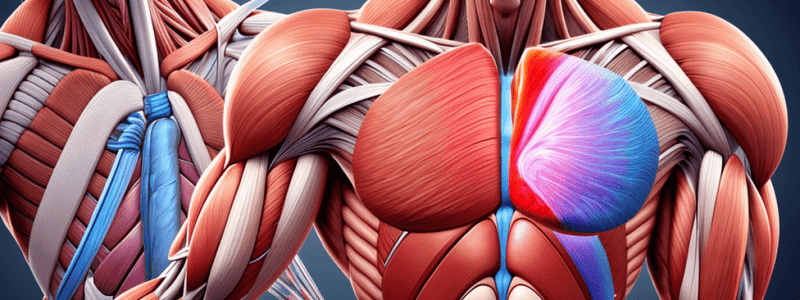Podcast
Questions and Answers
Which muscle group is primarily responsible for moving the arm outwards and away from the body?
Which muscle group is primarily responsible for moving the arm outwards and away from the body?
- Deltoid (correct)
- Hip flexors
- External obliques
- Pectoralis major
Which muscle group is mainly involved in flexing the elbow (bending the arm)?
Which muscle group is mainly involved in flexing the elbow (bending the arm)?
- Gluteus maximus
- Triceps
- Biceps (correct)
- Quadriceps
Which muscle is crucial for extending the knee (straightening the leg)?
Which muscle is crucial for extending the knee (straightening the leg)?
- Quadriceps (correct)
- Latissimus dorsi
- Hip flexors
- Deltoid
Which muscle group is primarily involved in rotating the trunk sideways?
Which muscle group is primarily involved in rotating the trunk sideways?
Which muscle group is primarily responsible for hip extension (moving the leg backwards)?
Which muscle group is primarily responsible for hip extension (moving the leg backwards)?
Match the following actions with their corresponding muscle group:
Match the following actions with their corresponding muscle group:
Match the following actions with their corresponding muscle group:
Match the following actions with their corresponding muscle group:
Match the following actions with their corresponding muscle group:
Match the following actions with their corresponding muscle group:
Match the following actions with their corresponding muscle group:
Match the following actions with their corresponding muscle group:
Match the following actions with their corresponding muscle group:
Match the following actions with their corresponding muscle group:
What muscle group is primarily responsible for hip extension?
What muscle group is primarily responsible for hip extension?
Which muscle is mainly involved in flexing the elbow?
Which muscle is mainly involved in flexing the elbow?
What muscle is crucial for extending the knee?
What muscle is crucial for extending the knee?
Which muscle group is primarily responsible for moving the arm outwards and away from the body?
Which muscle group is primarily responsible for moving the arm outwards and away from the body?
What muscle group is primarily involved in rotating the trunk sideways?
What muscle group is primarily involved in rotating the trunk sideways?
Flashcards are hidden until you start studying
Study Notes
Types of Muscles
- There are three types of muscles in the body: smooth, cardiac, and skeletal.
Smooth Muscle
- Found in internal organs and blood vessels.
- Involuntary muscle, meaning it's not under conscious control.
Cardiac Muscle
- Found only in the heart.
- Involuntary muscle, meaning it's not under conscious control.
Skeletal Muscle
- Attached to the skeleton.
- Voluntary muscle, meaning it's under conscious control.
Muscle Fibers
Type I Fibers
- Needed for endurance activities, such as long-distance cycling.
- Muscles are red in color due to the high amount of capillaries transporting oxygenated blood.
- Allow muscles to work for a long duration without getting tired.
Type IIx Fibers
- Needed for high-intensity, short-duration activities, such as sprinting.
- Muscles contract quickly and produce a lot of force.
- Muscles tire quickly, limiting the duration of high-intensity activity.
Studying That Suits You
Use AI to generate personalized quizzes and flashcards to suit your learning preferences.




